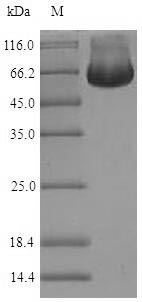The production of recombinant human RuvB-like 2 (RUVBL2) in E. coli starts with co-cloning the gene encoding the the full length of mature RUVBL2 protein (2-463aa) into an expression vector and transforming it into E. coli cells. These cells are cultured under conditions that induce protein expression. After sufficient growth is achieved, the cells are lysed to release the recombinant RUVBL2 protein. Purification is achieved by affinity chromatography. The purity of the 90% protein is assessed using SDS-PAGE, reaching over 90%.
Human RUVBL2 is a member of the AAA+ (ATPases associated with diverse cellular activities) family of proteins. It forms a complex with RUVBL1, RPAP3, and PIH1D1, known as the R2TP complex, which acts as an HSP90 co-chaperone essential for the maturation of various multiprotein complexes involved in critical cellular processes [1][2]. RUVBL2 plays a crucial role in the assembly and composition of the γ-tubulin ring complex (γTuRC) in human cells [3]. Moreover, RUVBL2 has been implicated in various biological functions such as DNA damage repair, transcriptional regulation, chromatin remodeling, and pro-inflammatory responses in macrophages [4][5]. Studies have shown that RUVBL2 is overexpressed in human hepatocellular carcinoma and is involved in oncogenesis, cell proliferation, and survival in leukemia [6][7]. Additionally, RUVBL2 interacts with clock proteins to regulate the circadian phase in mammals [8].
References:
[1] H. Muñoz-Hernández, M. Pal, C. Rodríguez, R. Fernández-Leiro, C. Prodromou, L. Pearlet al., Structural mechanism for regulation of the aaa-atpases ruvbl1-ruvbl2 in the r2tp co-chaperone revealed by cryo-em, Science Advances, vol. 5, no. 5, 2019. https://doi.org/10.1126/sciadv.aaw1616
[2] C. Rodríguez and Ó. Llorca, Rpap3 c-terminal domain: a conserved domain for the assembly of r2tp co-chaperone complexes, Cells, vol. 9, no. 5, p. 1139, 2020. https://doi.org/10.3390/cells9051139
[3] F. Zimmermann, M. Serna, A. Ezquerra, R. Fernández-Leiro, Ó. Llorca, & J. Lüders, Assembly of the asymmetric human γ-tubulin ring complex by ruvbl1-ruvbl2 aaa atpase, Science Advances, vol. 6, no. 51, 2020. https://doi.org/10.1126/sciadv.abe0894
[4] L. Hua, W. Sui, W. Li, Q. Tan, J. Chen, X. Linet al., Integrated microrna and protein expression analysis reveals novel microrna regulation of targets in fetal down syndrome, Molecular Medicine Reports, vol. 14, no. 5, p. 4109-4118, 2016. https://doi.org/10.3892/mmr.2016.5775
[5] R. Zhang, C. Cheung, S. Seo, H. Liu, L. Pardeshi, K. Wonget al., Ruvbl1/2 complex regulates pro-inflammatory responses in macrophages via regulating histone h3k4 trimethylation, Frontiers in Immunology, vol. 12, 2021. https://doi.org/10.3389/fimmu.2021.679184
[6] B. Rousseau, L. Ménard, V. Haurie, D. Taras, J. Blanc, F. Moreau‐Gaudryet al., Overexpression and role of the atpase and putative dna helicase ruvb-like 2 in human hepatocellular carcinoma, Hepatology, vol. 46, no. 4, p. 1108-1118, 2007. https://doi.org/10.1002/hep.21770
[7] H. Osaki, V. Walf-Vorderwülbecke, M. Mangolini, L. Zhao, S. Horton, G. Morroneet al., The aaa+ atpase ruvbl2 is a critical mediator of mll-af9 oncogenesis, Leukemia, vol. 27, no. 7, p. 1461-1468, 2013. https://doi.org/10.1038/leu.2013.42
[8] D. Ju, W. Zhang, J. Yan, H. Zhao, W. Li, J. Wanget al., Chemical perturbations reveal that ruvbl2 regulates the circadian phase in mammals, Science Translational Medicine, vol. 12, no. 542, 2020. https://doi.org/10.1126/scitranslmed.aba0769






